24 November, 1998
Tuesday November 24, 1998
Greetings from 9915 miles away from Flint Hill, Oakton, VA
After a typical humdrum start, working for 3 hours in the darkroom
until 9AM, today quickly turned into a fabulous day that I will never
forget! Because of a connection arranged for us by Sandy Calhoun and
Ginny Figlar of the newspaper here, Betty Trummel (another TEA
teacher) and I were invited to spend the day at Big Razorback Island,
part of the crater edge of an ancient volcano which is now mostly
submerged in the frozen sea. Here we were able to learn about and
parcticipate in the long-term research that has been going on with
Weddell Seals since it was started in the summer of 1968-69 by Dr. Don
Siniff of the University of Minnesota. The seal group has a webpage
which describes their research and has excellent recordings of the
bizarre medley of sounds made by Weddell Seals. It also shows maps of
the study area which includes parts of Ross Island near McMurdo which
I have mentioned in previous journals. Check out their website at
http://siniff3.ecology.umn.edu
So at 10:15 Betty and I bundled up for protection against the cold
wind and rode off across the frozen Ross Sea on our snowmobiles. It
was a spectacular, crystal-clear, blue-sky day. There was not a single
cloud in the sky and there was no haze from air pollution. This
continent is known to have the cleanest air in the world. This was
quite different from your typical commute to school or work. The
snowmobile didn't conk out on me this time and when we turned the
corner away from McMurdo into the spectacular scenery that I have
already mentioned so many times, the feeling of exhilaration and
freedom was what all you students will feel at the beginning of
Christmas vacation. By 11:50 we arrived at Big Razorback where we were
warmly greeted by Don Siniff and 7 of his graduate students from the
University of Minnesota who emerged from three little orange huts
which is their home and lab on the ice.
LIFE IN A FIELD CAMP
What is it like to live in a field camp? The huts have no running
water but they are kept warm and cozy by an oil stove. They use an
outdoor outhouse for a bathroom. The wastes are collected in a barrel
and returned to McMurdo for proper disposal. About once a week the
researchers ride their snowmobiles into town for a nice hot shower and
to check their e-mail and pick up supplies. Most field camps do not
have this luxury. They have an electric generator to power their
computers and lab equipment. They have a telephone for communication
with McMurdo and hand-held radios for communication between themselves
when some of them are in the field. The shelves are well stocked with
pasta, canned foods, candy bars, beverages, and even Chips Ahoy
cookies. They cook using a Coleman camping stove using melted snow as
a source of water. And their kitchen hut (where 2 of the graduate
students also live) has a picture window looking out across the ice at
a superb view of Mt Erebus and a big iceberg that is frozen in the sea
ice. Space is cramped. But the closeness to the wonderful,
overwhelming wilderness of Antarctica all around you, separated by
only a thin hut wall, where you can easily hear the wind whipping by
and the weddell seals wailing, and where, when the generator is off
and the seal pups and skuas are silent, you can sometimes sit still
and in the calm air hear absolutely nothing....absolutely
nothing....this must be an experience that is worth every inconvenience.
The typical schedule of this team of researchers is to sleep in
until 9AM, then do various camp chores, and then get on with the
research of the day which may continue until 10 PM. This research
usually involves tagging individual pups and adults with numbered
colored plastic tags that are inserted into the hind flippers so they
can keep track of the movements and life history of invididuals when
they see them again. (This is the same thing we do at Flint Hill with
bird banding and cricket marking.) Other research involves taking
small blood samples to test the blood for diseases, or epoxying
radio-transmitters onto the backs of adult male seals so they can keep
track of the bulls' movements and territories using a pair of tall,
solar-powered antennae at the camp.
Then before bed, the researchers log the data from the day's work
into the computers and finally "hit the hay" at about 2 or 3 AM, in
broad daylight. Every three days, weather permitting, they go
throughout their study area by snowmobile, censusing how many seals
are in each location and especially where the tagged individuals are.
During field work all the raw data is carefully recorded in hand-held
field data computers.
OUR TOUR
Mike Cameron, a PhD student who seemed to be the guy in charge, was
an excellent teacher as he led us around the perimeter of Razorback
Island describing the life-cycle of the Weddell Seals and the
different types of research that are going on. He was repeatedly
interrupted by our enthusiastic questions and by the behavior of the
seals. Cute cuddly seal pups nuzzling milk from their momma's mammary
glands, pups wailing and bleating to get their mother's attention,
seals coming up onto the ice through holes or going the opposite
direction, bizarre video-game-like sounds wafting up though the ice
from seals singing below, the slushing sound of seal teeth scraping
against ice to enlarge a hole or to make it more step-like, easier for
the pup to exit the water, seals passing gas, and seals blowing
bubbles in the water....these were all distractions that kept
interrupting our fascinating lecture by Mike. Repeatedly I was
distracted by the pressure ridge ice formations caused by currents and
tides pushing the ice up against the land of Razorback Island forming
beautiful sculptures of white and blue blocks. At one end of the
island a huge, blue-and-intensely-white iceberg sculpted by wind and
sun, was frozen in the ice. Everywhere I turned I saw scenery I wanted
to photograph, with resplendently white Mt Erebus and its small plume
of volcanic smoke always there in the background, so I clicked away as
Mike patiently explained the life history of the Weddell Seal, the
furthest south population of seals in the world.
Long-term studies of populations are very important, especially
if the species studied has a long life span. Weddell Seals can live
for at least 20 or 30 years. Since 1972, every pup born in the study
area has been tagged, and over 120,000 individual sightings of the
13,500 marked seals have been logged. Here are some of the things
that Dr Siniff's team has been able to discover over the years:
1. Individual seals do not stay in one colony year after year.
They wander around breeding for a few years in one colony and then
moving to another. Both males and females are just as likely to
wander to different colonies. Individuals from outside the study area
immigrate in, and individuals from this study area emigrate out and
are sometimes seen tens of miles away. This tendency to ramble is very
different from a lot of mammals and birds who have a set home range or
territory. This helps to prevent these long-lived individuals from
inbreeding and helps to keep the genetic variety in the gene pool high.
2. The breeding of Weddell seals is amazingly synchronous. In other
words all the pups are born within a very short time of one another.
Here near Mt Erebus the birthing time is around Halloween. Once,
during a period of only two days, the seal team tagged 200 newborn
seal pups. That is a pretty high number for such a short period
considering that they only tag around 350-550 a year. This is very
different from the Galapagos Sea Lions that I see with my students
every few years on the Equator. In the tropics the environmental
conditions are fairly constant all year so the sea lions can have pups
at any time of year and still be able to find food easily. But here
in Antarctica with the extremes of the cold, dark winter and the
balmy, daylit summer when the food supply is abundant, it is important
for the pups' survival to be born at the right time.
(QUESTION TO THINK ABOUT: Why is there so much more food present in
the summer? Hint: Think of the melting sea ice, releasing ice-algae
and micro-organisms, and their effect on the food web.)
3. The pups are 60 pounds when they are born! (WOW! Imagine being the
mother giving birth to a 60 pound baby! UGH!) Then they quickly grow,
nourished by the mother's extremely fatty and highly nutritious milk,
so that by the time they are 6 weeks old they are almost full-grown
and can go off on their own. (That's pretty fast growth! Much quicker
than the normal growth rate of tropical Galapagos sea lions who may
accompany their mother around for months at a time.) While the baby is
growing fatter and fatter, the mother is growing skinnier and
skinnier. For every pound the baby gains the mother loses 2 pounds.
Sometimes it seems that the mother gets so tired of the baby's
constant demands for food that she will just slide off the ice through
the icehole into the nice quiet depths where she can get away from it
all for a few minutes. I bet your parents sometimes feel like this too!
When the pup is 3-4 weeks old the mother starts leading the pup
into the water. I wonder how the icy water feels to a pup the first
time he goes in! Mike says the hesitant behavior and the startled
expression on their face is quite comical. When the baby wants to
climb back out onto the ice the mother may cut away the ice so the pup
can climb up more easily, or she might even give him a boost with her
head, but still some pups cannot get out and drown. We found one
frozen pup floating in an ice hole. Maybe he was unable to climb out
of the hole and drowned. We don't know.
4. After 6 weeks the pup is big and fat, you might even say obese.
Then the mother leaves the pup for good. The pup sits around for
awhile and he gets so hungry that he goes off to find food on his own.
This is the hardest time in a seal's life. The highest seal mortality
is in the first year of life. Over 1/2 of them die. This is true of
most wild animals. But if they make it through this year they have a
good chance of living a full lifespan of 20-30 years. Those who live
to adulthood (5-7 years old) have a 98% survival rate.
The seals who make it through the first winter wander around for
several years and then return to one of the colony sites at about 7
years old to have their first babies, one pup per female.
QUESTION TO THINK ABOUT:
Last year was a tremendous year for Weddell Seal birthing: 550 pups
in an area where the average is 370. What explanations can you give
about why so many were born last year? E-mail your answers to me and
I'll e-mail you back.
RETAGGING SEALS
After a lunch of fried Burritos with salsa we went by snowmobile
around two other islands (Tent Island and Inaccessible island) to
catch any seals whose tags had been broken so we could retag them.
Dan Monson, a wildlife biologist, called this cowboy science, and I
can see why. He would walk up behind the seal, carefully (but quickly
and forcefully) throw a large, black hood over the seal's head so it
couldn't see, and then sit on the back of the seal. Sometimes the seal
would buck like a bull for a few seconds but after a very short time
the darkness would calm the seal down and Mike Cameron would put new
tags on the flippers while Dan sat on the seal's back. This process is
harmless to the seals. They just sit there as if nothing has happened
when it is over. There is a little bit of blood oozing from the
flipper but it quickly heals in the saltwater, and the seals don't
even seem to notice the small cut. They are used to huge gashes
inflicted by other seals in fights so this is just a little scratch to
them.
Normally, according to the Antarctic treaty, wildlife cannot be
disturbed in Antarctica. If you get so close to an animal that it
moves away or even raises its head to look at you, you have disturbed
it and technically you have violated the treaty. Mike, Dan, and the
others all have permits to do their research allowing them to handle
them in this way. Since we were helping them this day, we also fell
under this permit and in order to check the conditon of the tags we
often had to touch the wonderful velvetty fur on their hind flippers.
What a great experience!
I learned tons and it was great to see
long-term research in action, to hear about what is being studied (and
how), and about what is known and not known about the life cycle of
Weddell Seals. Getting out of the lab to a spectacular place like
Razorback, to work with such wonderful critters as Weddell Seals, to
hear their bizarre range of vocalizations, to touch their velvetty
fur, to look into their soulful eyes, to watch their behavior, to be
thrilled by the majesty of a towering sculpted iceberg and masses of
pressure ridges... .all of this was overwhelmingly mind-boggling, it
was like a fantasy, and it reminded me of why I wanted to come to
Antarctica. I was starting to forget why I came, but this excursion
reminded me. It is a day I will never forget and I will share it all
with my students. I hope that some of them will be inspired to do
science either here or elsewhere as a result.
I hope you have a good day and do something good for someone.
Fred Atwood
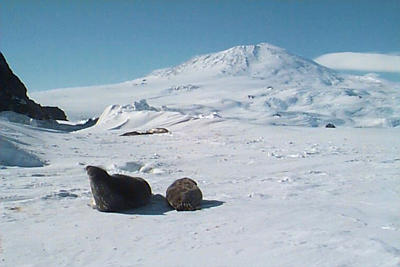
A mother Weddell Seal with her month-old pup near some pressure ridges at Big Razorback island. Mt Erebus is in the background.
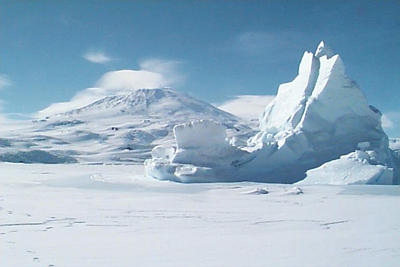
The beautiful iceberg near Big Razorback island with Mt.Erebus in the background.

Pam Yochem holds the blood samples she extracted from several seals in order to study the diseases and health of the Weddell Seals in the area. Obtaining the blood does no harm to the seals.
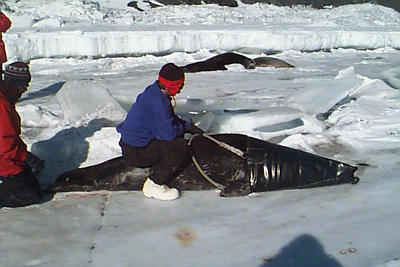
Dan Monson sits astride a Weddell seal which he has hooded to keep it calm so it won't hurt itself or the researchers. Mike Cameron gets ready to replace a damaged flipper-tag.
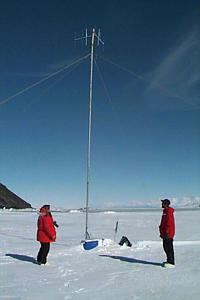
Betty Trummel and Mike Cameron stand next to the antenna used to sense the messages broadcast by the radiotransmitters super-glued to the back of bull seals. Tom Gillette is the graduate student (not shown) doing this study on the movements, range, and territories of bull seals during breeding season. You can see the solar panel used to power the apparatus's battery.
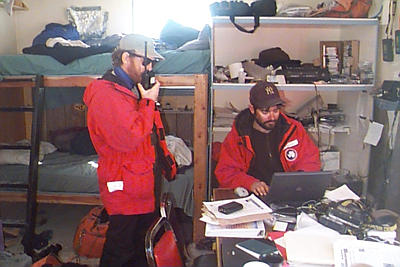
Brent Stewart receives a radio call from Tom Gilette in the field about a parcticular tagged individual that Tom has found. Mike Cameron checks out the database on the laptop computer to find out if Tom has obtained blood from t hese seals for DNA analysis. Tom is trying to use DNA analysis to determine which bull fathered the pups in a certain area.
Contact the TEA in the field at
.
If you cannot connect through your browser, copy the
TEA's e-mail address in the "To:" line of
your favorite e-mail package.
|
